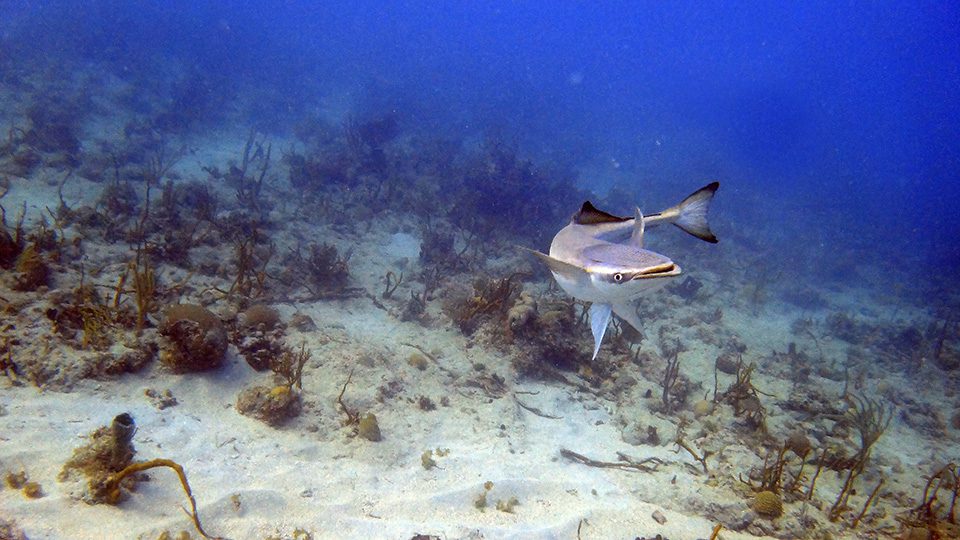
By Peter Cammann
Most anglers don’t target remoras. However, if you drifted your bait past a cruising shark and a remora attached to the big fish took it, you would be treated to a terrific fight as both animals tussled with you. Eventually the remora would let go of its host, allowing you to haul it in. You might then spend the rest of the day wondering how your 15 to 16-inch catch had felt more like…well…a hundred-pound shark, right?
What is remarkable is that there are odd accounts of remoras having been used to catch fish and other sea animals throughout history. One of the oldest of these stories sparked a lively debate among prominent naturalists at the turn of the 20th century. The catalyst was a report that was alleged to come from Christopher Columbus’ second voyage to the New World in 1494 taken from his son Ferdinand’s notes of an incident off the coast of Cuba:
“They had ty’d some small fishes they called Reverso [remora] by the tail, which run themselves against other fish, and with a certain roughness they have from head to the middle of the back they stick fast to the next fish they meet; and when the Indians perceive it drawing their line, they hand them both in together. And it was a tortoise our men saw so taken by those fishermen, that fish (the Reverso) clinging about the neck of it, where they generally fastened, being by that means safe from the other fish biting them; and we have seen them fastened upon vast sharks.”
Charles Frederick Holder, a leading naturalist who served as a curator at the American Museum of Natural History in New York City during the late 19th century became fascinated by this story and decided to see if he could replicate the act of remora wrangling it in the field, using a one to catch a sea turtle. In a 1905 paper he wrote on the subject, he reported:
“I experimented with the Remora but the fish invariably refused to dart after the turtle, preferring to find shelter under the boat. One tossed to a shark was seized by the latter, that doubtless thought it a votive offering. Possibly something was wrong: our remoras may have been stale: they surely were not ship or turtle slayers.”
The odd concept of “stale” remoras aside, Holder’s observations were widely respected at the time. Not only was he a highly regarded scientist, he was also cited as being one of the first great tuna fisherman of his time and renowned for his writings on deep-sea fishing.
The noted ichthyologist Dr. Eugene Willis Gudger investigated Columbus’ story as well and eventually weighed in with his own observations in a 1919 paper published in The American Naturalist. Gudger let a remora that he had caught attach itself to the boat deck. He then grabbed its tail and gave it a good hard yank. The fish only started to let go once the disk on its head actually began to tear off! While his is not to suggest that the great body of Gudger’s other research was anything but thorough and precise, it does make you wonder what possessed him on that particular day.
There were some somewhat less-disturbing studies being done at about the same time by Dr. Charles Haskins Townshend, a man who served as the director of the New York Aquarium between 1902 and 1937. Townshend used various sized remoras to lift weighted buckets out of the water. He found that once the remora had attached itself to a bucket, it could easily hold onto objects weighing almost 25 pounds and could then be hauled to the surface. He had somewhat limited success though using remoras to capture sea animals, even under these controlled conditions. When the remora was pulled to the surface, it released the bucket.
Researchers might have done better to look for documented sightings of Caribbean fishermen to ascertain whether the remora could successfully be used to harvest fish. One of the most persuasive of these accounts was penned by the noted British travel writer Lady Annie Brassey, whose books on her sailing trips around the globe were bestsellers during the 1870’s and ‘80’s. On an 1885 voyage she observed fishermen working with remoras in the waters off Venezuela and wrote:
“Arrived at the field of operations, the fisherman lets go an anchor and puts the sucking-fish, attached to a long line with a buoy at the end of it, overboard. It sees other fish at a great distance, darts after them, and attaches itself to them by means of the sucker on top of its head. The Indian easily raises his little anchor, paddles leisurely after the remora, removes the captured fish into his canoe, and repeats the operation until he has caught as many fish as he wants.”
Lady Brassey’s observations showed that the practice was real and that Columbus had been right all along. Sadly, she passed away only two years after she wrote this dispatch, at the age of 47, on a voyage to Mauritius, a British colony located off of the east coast of Madagascar.
One last fun fact: There are indications that Caribbean fishermen sometimes chose to kill the remoras they had wrangled at the end of the day and then consumed them, a somewhat impolite reward for services rendered.
Peter Cammann is the author of several books and his work has been featured work in On the Water, Coastal Angler, The Fisherman, Field & Stream, Outdoor Life, Fly Fisherman, Vermont Life, and New England Game and Fish, and on various web sites, including Coastal Angler, About-Flyfishing and UrbanDesires. View his books here: https://www.amazon.com/stores/author/B001KIQIPW